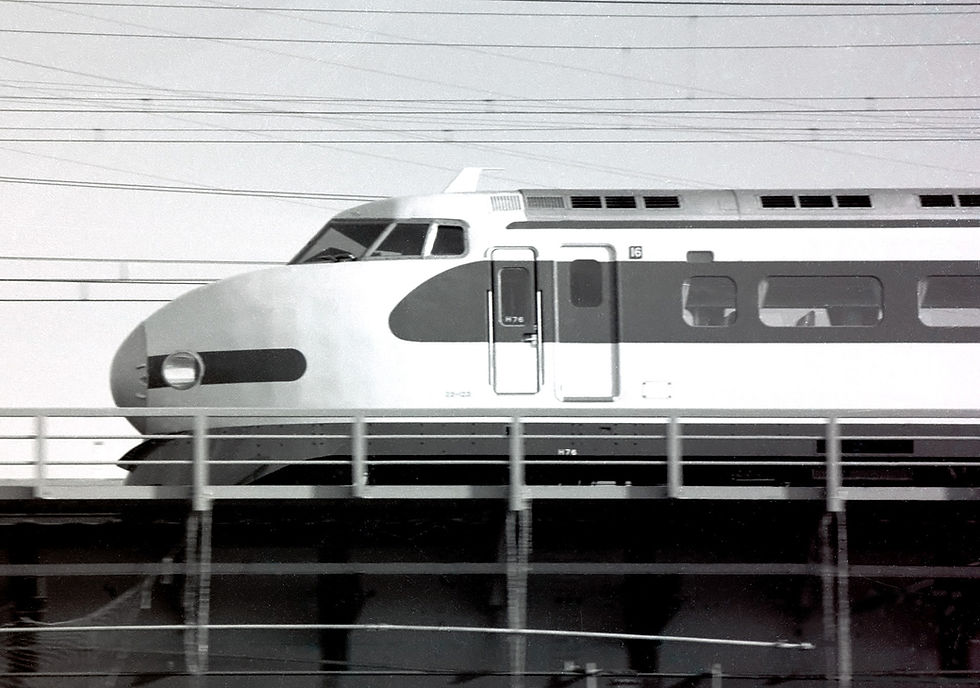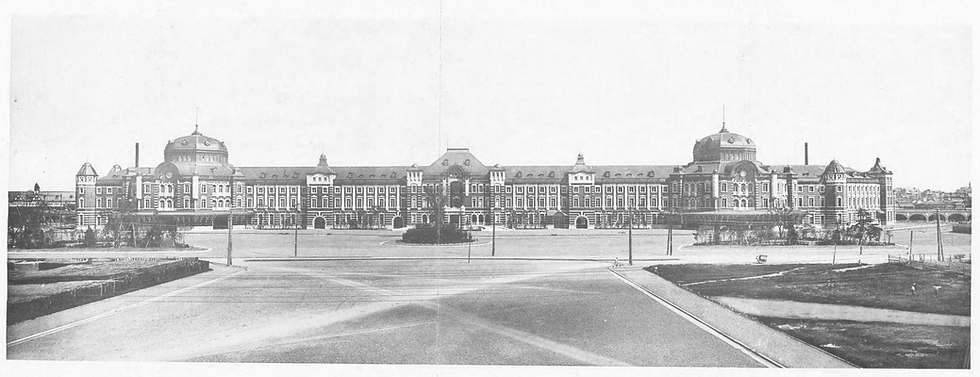Tokyo Station: Resurrection of a Modern Capital — Part II | MK Deep Dive
- M.R. Lucas
- 1 day ago
- 4 min read

In 1946, as Japan worked to recover from the war’s destruction, Tokyo Station entered a new phase of rebuilding — one marked not by grandeur but by survival. The domes that once crowned the Marunouchi Building like twin imperial halos had been lost, destroyed in the 1945 firebombing. In their place, simple octagonal hipped roofs with a flattened, pyramidal shape replaced them, often described as Babylonian or Egyptian in style. It was a practical choice for a country with limited resources and deeper wounds to heal. Architectural confidence had faded into austerity; what was once proud and ornate was now plain and functional.
Missed Part I? Start with:

Throughout the 1950s, the station took on an even more modest appearance. What was once a three-story masterpiece was reduced to two stories. Japan was rebuilding quickly, but Tokyo Station still stood as a symbol of caution — a place where safety was prioritized over aesthetics. The city had survived earthquakes, firebombings, and political upheaval; humility became its architectural language.
And then, as the Shōwa era matured, Japan’s rebirth accelerated. On October 1, 1964 — the 39th year of Shōwa — Tokyo was on the verge of hosting the Olympic Games. The world’s attention centered on the capital, and the country buzzed with eager anticipation. Postwar Japan was stepping onto an increasingly global stage, uncertain yet determined. Tokyo Station, humble yet resilient, remained the gateway to that new identity.
But the clear symbol of Japan’s technological comeback came not from its history, but from its future.
That same day, the Tōkaidō Shinkansen became a reality. The world’s first high-speed railway — the legendary “bullet train” — started service shortly after dawn. Its inaugural 6:00 a.m. departure linked Tokyo and Shin-Osaka in a remarkably short time, connecting the capital to the Kansai region’s industrial core at an unprecedented speed. Trains ran along the line at nearly 210 km/h (130 mph), leaving even the most advanced Western rail systems decades behind. In the United States, Amtrak barely kept up; in Europe, high-speed rail was still just a dream.
The Shinkansen was more than just infrastructure. It was a declaration of rebirth — a sharp, blue-and-white arrow of confidence rising from the ruins.
Tokyo Station’s Shinkansen platforms — built in just three years — became the heart of a nation experiencing its economic boom. Speed now defined modernity, and Japan’s railways set a worldwide standard.
Progress persisted. In 1972, Japan marked the centennial of its railroads with a new milestone: the opening of the Hibiya Line station beneath Tokyo Station. For the first time, commuters descended deep underground, going down five steep escalator flights — 28 meters below street level. The descent felt almost surreal, like an animated character unsure whether to ascend toward the pearly gates or descend into a futuristic cavern — remarkable considering this same ground had been rubble from the firebombings only decades earlier. Now it was a layered, living city.
The Marunouchi district around Tokyo Station underwent an even faster transformation. Skyscrapers rose sharply into the sky; cranes moved rhythmically across the horizon. Redevelopment happened again and again in a district that, like the station itself, refused to stand still. Each era physically layered itself onto the previous one. What Tatsuno Kingo designed as a formal, symmetrical gateway is now at the heart of a hyper-modern financial district — still iconic, but now surrounded by glass and ambition.
Yet beneath the postwar roofline and hipped pyramids, the spirit of the original Tokyo Station endured. By the 1990s and early 2000s, public sentiment shifted. What had once been seen as outdated Meiji-era nostalgia was now recognized as cultural heritage. The question arose: How does Tokyo — a city built on reinvention — honor what it almost lost?
The answer was one of Japan's most ambitious restoration projects ever undertaken.

In 2007, the full-scale reconstruction of the Marunouchi Building began. The goal was as ambitious as it was delicate: to restore Tokyo Station to its 1914 appearance while strengthening it with modern engineering. Architects and historians carefully examined photographs, blueprints, archival materials, and even original bricks to recreate Tatsuno’s masterpiece.
The domes were carefully restored — rebuilt with precision, their copper shining brightly over the city. Carved designs of white doves, representing peace and renewal, adorned their interiors. The third floor, lost during the war, was reconstructed. Damaged brick walls were replaced with new bricks carefully fired to match the Meiji-era texture and color. The Tokyo Station Hotel and Tokyo Station Gallery were seamlessly reintegrated, restoring the original layout from a century ago.
And beneath this renewed facade lay an engineering marvel: advanced seismic base-isolation systems, invisible yet vital, ensuring that the restored station could withstand the earthquakes shaping Japan’s future.
On October 1, 2012 — almost a hundred years after Tokyo Station first opened — the restored Marunouchi Building was unveiled. The domes shone again against a skyline of steel and glass. A hundred years of ambition, destruction, resilience, and renewal had come full circle. Tokyo Station once more stood not just as a transit hub but as a cultural symbol, a piece of national memory, and one of Japan’s most iconic architectural achievements.
What started as a Meiji dream rose once more as a testament to Japan’s unbreakable resilience.
MK Take
Tokyo Station’s revival reflects Japan’s postwar journey — from ruin to rebirth, from humility to confidence, from devastation to innovation. From the Shinkansen’s debut to the restoration of Tatsuno’s domes, the station’s development highlights a city that constantly balances its history and future. Its restored brick walls and gleaming copper curves tell a story not just of architecture but of spirit, resilience, and the unbreakable heartbeat of a nation committed to rising, rebuilding, and renewing.

Let MK guide you through Tokyo Station’s postwar revival — where broken domes, new railways, and a nation’s rebirth came together to reshape the city’s core.
Image Credits
Shellparakeet, CC0 via Wikimedia Commons
wilford peloquin, CC BY 2.0 via Wikimedia Commons
PekePON, CC BY-SA 3.0 via Wikimedia Commons
名無し野電車区, CC BY-SA 3.0 via Wikimedia Commons
RuinDig/Yuki Uchida, CC BY 4.0 via Wikimedia Commons









Comments